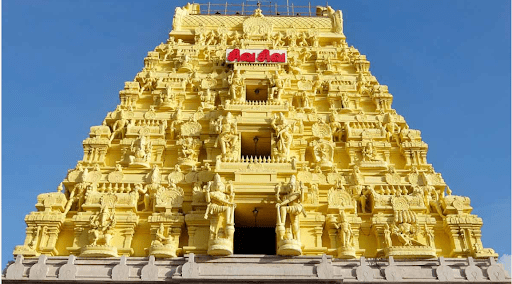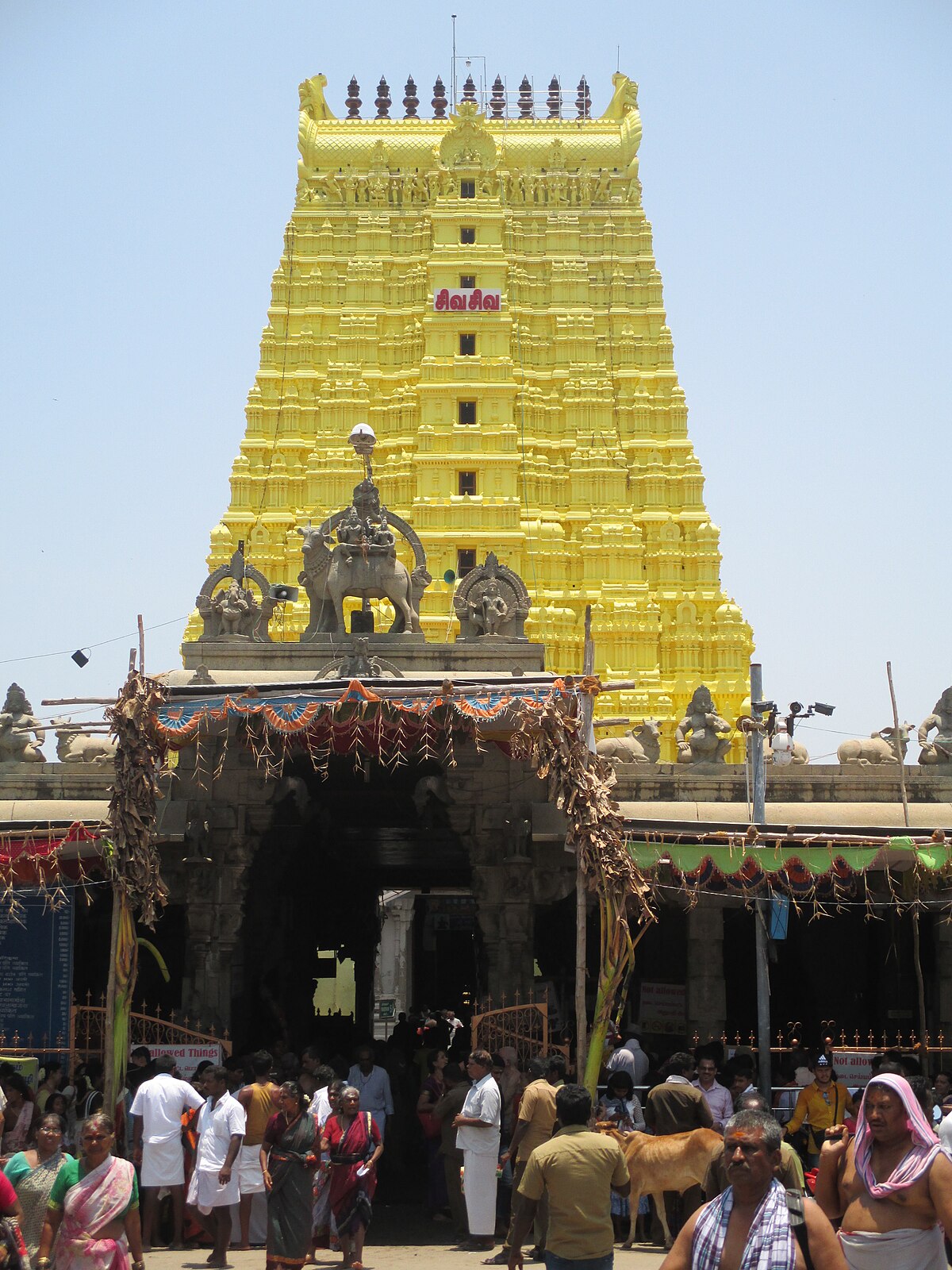
Ramanathaswamy Temple – Rameshwaram
This temple located in the sacred town of Rameswaram in Tamil Nadu, India, stands as one of the most revered pilgrimage sites for Hindus. Dedicated to Lord Shiva, the temple holds immense religious significance and is considered one of the twelve Jyotirlinga shrines, representing the infinite cosmic light of Shiva. The temple’s history dates back centuries, and its architectural grandeur reflects the Dravidian style, showcasing intricate carvings and a magnificent corridor. What makes Ramanathaswamy Temple unique is the belief that a pilgrimage to the temple and the ritual bathing in the sacred water of Agni Theertham can absolve one of sins. Pilgrims from all corners of the country visit this spiritual haven to seek the blessings of Lord Shiva and partake in the rich cultural and religious heritage that Ramanathaswamy Temple embodies.
Historical background and Architectural splendor
According to Hindu mythology, Lord Rama, on his return from Lanka after defeating the demon king Ravana, wanted to worship Lord Shiva to absolve any sins incurred during the war. To facilitate this, Lord Hanuman was dispatched to Mount Kailash to bring back a Lingam. However, there was a delay, and Sita, the wife of Lord Rama, created a Lingam out of sand on the shores of Rameswaram. When Lord Rama returned, he established this Lingam, and it became the central deity of the Ramanathaswamy Temple.
The temple’s architecture is predominantly Dravidian style, characterized by towering gopurams (entrance towers), intricately carved pillars, and a vast corridor. The temple complex spans 15 acres and is one of the largest in India. The temple’s famous corridor, also known as the third corridor, is renowned for being the longest in the world, stretching for about 1,212 meters and featuring over 3,600 pillars. The architectural marvel of the temple is evident in its precise construction and the intricate detailing on the sculptures, depicting various mythological stories.

Religious Significance
This temple holds profound religious significance in Hinduism, drawing pilgrims from across the country to its sacred precincts. Dedicated to Lord Shiva, the temple is revered as one of the twelve Jyotirlinga shrines, symbolizing the infinite cosmic light of Shiva. According to Hindu mythology, the Lingam (an iconic representation of Shiva) enshrined in the temple was consecrated by Lord Rama himself, making it a site of immense spiritual importance. Pilgrims believe that a visit to Ramanathaswamy Temple and the sacred ritual of bathing in the Agni Theertham, a holy water tank near the temple, can cleanse one of sins and facilitate spiritual purification. The temple complex encapsulates various shrines and sacred tanks, each with its own mythological significance. The Sethu Madhava Theertham is believed to be the spot where Lord Rama performed a ceremony to honor his ancestors. The significance of Ramanathaswamy Temple is further accentuated by the belief that it is a part of the sacred Char Dham Yatra, and a pilgrimage to Rameswaram is considered incomplete without a visit to this revered site. The temple's religious allure is not only rooted in its historical connection to the epic Ramayana but also in the vibrant rituals, ceremonies, and festivals that continue to be observed, creating a spiritual ambiance that resonates with devotees and visitors alike.

Festival and Celebrations
This temple hosts various festivals and celebrations throughout the year, adding vibrancy to its spiritual atmosphere. Some of the prominent ones are Maha Shivaratri, Thai Amavasai, Navaratri, Aadi Amavasa, Mahalaya Amavasya, Kartik Poornima, Sethu Karai Theertham Float Festival and Ramalinga Prathista Utsavam and Agni Nakshatram.
Surroundings area & attractions
- Agni Theertham: A sacred sea located near this temple, where pilgrims perform ablutions before entering the temple. The belief is that a dip in this holy water can absolve sins.
- Kothandaramaswamy Temple: Situated on a beautiful island, this temple is believed to be the spot where Vibhishana, the brother of demon king Ravana, sought refuge during the battle between Rama and Ravana.
- Jada Tirtham: A sacred pond near the Ramanathaswamy Temple, associated with a legend where Lord Rama washed his hair (jada) after the battle with Ravana.
- Villoondi Theertham: A freshwater tank near Gandamadana Parvatham, believed to have been created by Lord Rama by shooting an arrow into the ground to quench the thirst of Sita Maiya.
Visitor information
Entry Fee: No fee
Special darshan ticket - 300 to 500 per person
Timings :
- 5 am –1 pm
- 3pm – 9 pm
Darshan Days- All days
Address:
Rameswaram, Tamil Nadu 623526
Notable Events and Incidents
- Kumbabishekam Ceremony
- Rameswaram Bomb Blast
- Floating Stone Installation
- Consecration Ceremony (2017)
Connectivity :
- By Rail: Rameswaram has a railway station, Rameswaram Railway Station, which is connected to major cities in Tamil Nadu and other parts of India.
- By Air: The nearest airport to Rameswaram is Madurai Airport, which is well-connected to major cities in India. From Madurai, one can reach Rameswaram by road or rail.
- By Sea: Rameswaram is also connected by sea. Ferries operate between Rameswaram and Dhanushkodi, providing a unique and scenic mode of transportation.
FAQ
The Ramanathaswamy Temple is one of the most significant Hindu temples in India. It is dedicated to Lord Shiva and is believed to be one of the twelve Jyotirlinga temples, where Lord Shiva is worshipped in the form of a lingam (symbolic representation).
The temple is situated in the town of Rameshwaram, which is in the Ramanathapuram district of Tamil Nadu, India. It is located on Rameshwaram Island, which is connected to the mainland by the Pamban Bridge.
The Ramanathaswamy Temple is renowned for its intricate Dravidian style of architecture. The temple complex covers a large area and consists of various mandapams (halls), gopurams (towers), and shrines.
Yes, non-Hindus are allowed to visit the temple premises, but there are certain areas within the temple that are restricted to non-Hindus.
The temple is usually open from early morning to late evening. However, the timings may vary on special occasions and during festivals. It’s advisable to check the current timings before planning a visit.
Yes, visitors are required to dress modestly and adhere to the traditional dress code. Men are usually required to wear dhotis (traditional attire) while women are expected to wear sarees or salwar kameez.
The temple celebrates several festivals throughout the year, with the Maha Shivaratri festival being one of the most prominent ones. Other important festivals include Thaipusam, Navratri, and Arudra Darshanam.
Yes, it is believed that taking a holy dip in the sacred waters of Agni Teertham (sea) and Sethu Karai (bay) before visiting the temple is purifying and auspicious for devotees. This pilgrimage is known as “Sethu Snanam.”
Photography is generally not allowed inside the temple premises.
Rameshwaram is well-connected by road, rail, and air. The nearest airport is in Madurai, and the nearest railway station is Rameshwaram Railway Station. From there, the temple can be easily reached by local transportation or on foot, depending on the proximity of your accommodation.
According to Hindu mythology, Rameshwaram is the place where Lord Rama, along with his wife Sita and brother Lakshmana, built a bridge (known as Rama Setu or Adam’s Bridge) to Lanka to rescue Sita from the demon king Ravana.
The main attractions within the Ramanathaswamy Temple complex houses various mandapams (halls) such as the Thousand Pillar Hall and the Hall of Ramayana. The Agni Teertham, a sacred sea located near the temple, is also considered auspicious for bathing.
Yes, the temple boasts the longest corridor among all Hindu temples in India. Known as the “Ramanathaswamy Temple corridor,” it stretches for about 1,000 feet and features intricately carved pillars on either side. Pilgrims often perform pradakshina (circumambulation) of the corridors as part of their worship.
The temple conducts various rituals and ceremonies throughout the day, including Poojas (worship), Abhishekams (ritual baths), and Archanas (offerings).
Sethu Karai is associated with the mythical Rama Setu, and Agni Teertham believed to have been created by Lord Rama to appease Lord Shiva are two sacred bodies of water located near the temple. It is believed that taking a holy dip in these waters before visiting the temple absolves one of sins and helps in achieving moksha (liberation).
Yes, there are several guesthouses, lodges, and hotels available in Rameshwaram to accommodate pilgrims and tourists.
Yes, the temple undergoes an annual maintenance ritual known as “Kumbabishekam,” which involves consecrating the temple and its deities after a period of renovation and upkeep. This ceremony is considered highly auspicious and draws large crowds of devotees.
The Ramanathaswamy Temple has been patronized by various rulers and dynasties over the centuries, including the Cholas, Pandyas, and Nayaks. Its architecture and artwork reflect a blend of Dravidian, Vijayanagara, and Nayak architectural styles, making it an important cultural heritage site.
One popular legend states that the temple’s construction was supervised by the monkey-god Hanuman, who brought the sacred lingam from the Himalayas. Another legend suggests that the temple’s corridors were built by a woman named Leelavathi using her dowry money, earning her the title “Leelavathi Corridor.”
Rameshwaram Island is considered a sacred pilgrimage site due to its association with the Ramayana epic. The island’s geographical location, surrounded by the Indian Ocean and the Bay of Bengal, adds to its spiritual significance, making it a destination for devotees seeking spiritual purification and blessings.
